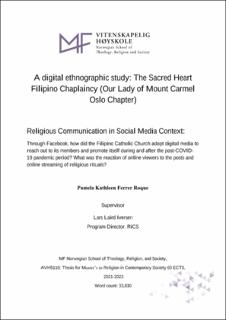A digital ethnographic study: the Sacred Heart Filipino Chaplaincy (Our Lady of Mount Carmel Oslo Chapter) : religious communication in social media context
Master thesis
Permanent lenke
https://hdl.handle.net/11250/3097241Utgivelsesdato
2023Metadata
Vis full innførselSamlinger
Sammendrag
This thesis studies how offline liturgical practices were expressed on the Facebook online platform during the Covid-19 worldwide Pandemic and the post-Pandemic period. Drawing on qualitative research and digital ethnographic method of the study conducted on The Sacred Heart Filipino Chaplaincy: Our Lady of Mount Carmel Oslo Norway Chapter's Facebook page (SHFC-OLMC). The qualitative data method that will be used is observation and content analysis of the Facebook page, including religious posts, digitized photos, and online live-stream broadcasting of the religious rituals. The focus is on the contents posted on the Church’s timeline covering the initial months of the SARS-CoV-2 outbreak lockdown period from March 2020 until March 2021 and the post-Pandemic period from December 2021- February 2022. Through Facebook, the research question is how the Filipino Catholic Church turned to the social media platform to continuously present religious messages and practices such as praying the rosary, novenas, mass celebrations, religious activities, and festivals among the Filipino community in Norway during the Pandemic. And how the online viewers reacted to this Church’s mode of communication through their online comments and emoji reactions. The aim is to understand how the Church’s Facebook social media platform has been utilized and may be viewed as a sacred space during the pandemic period, thereby turning the Internet into a worship space and serving as an agent of religious transformation and see what are the online viewers' reactions.
Based on digital ethnographic visual and content analysis, the data gathered will aim to answer the research question primarily by linking the data collected to recent studies provided in the literature review chapter and theories of the sociology of religion. Scholars in the past 20 years, like Lundby, Campbell, Hjarvard, and Lövheim who investigates the relationship between media, religion, and culture from the Nordic perspective will be referred to. In analyzing the religious catholics' reactions and comments when participating online during the mass broadcast, I will refer to Robert Orsi's (2005) theory of transcendence and lived experience of sacred presence. Also, I will refer to Christopher Helland's (2005) on Online religion as lived religion and Gunther Kress' (2010) Social Semiotics in the visual analysis of the photographs. This theory examines meaning in all of its manifestations, in every social setting, and in every cultural location.
